parking brake ACURA RL KA9 1996 Service Repair Manual
[x] Cancel search | Manufacturer: ACURA, Model Year: 1996, Model line: RL KA9, Model: ACURA RL KA9 1996Pages: 1954, PDF Size: 61.44 MB
Page 814 of 1954
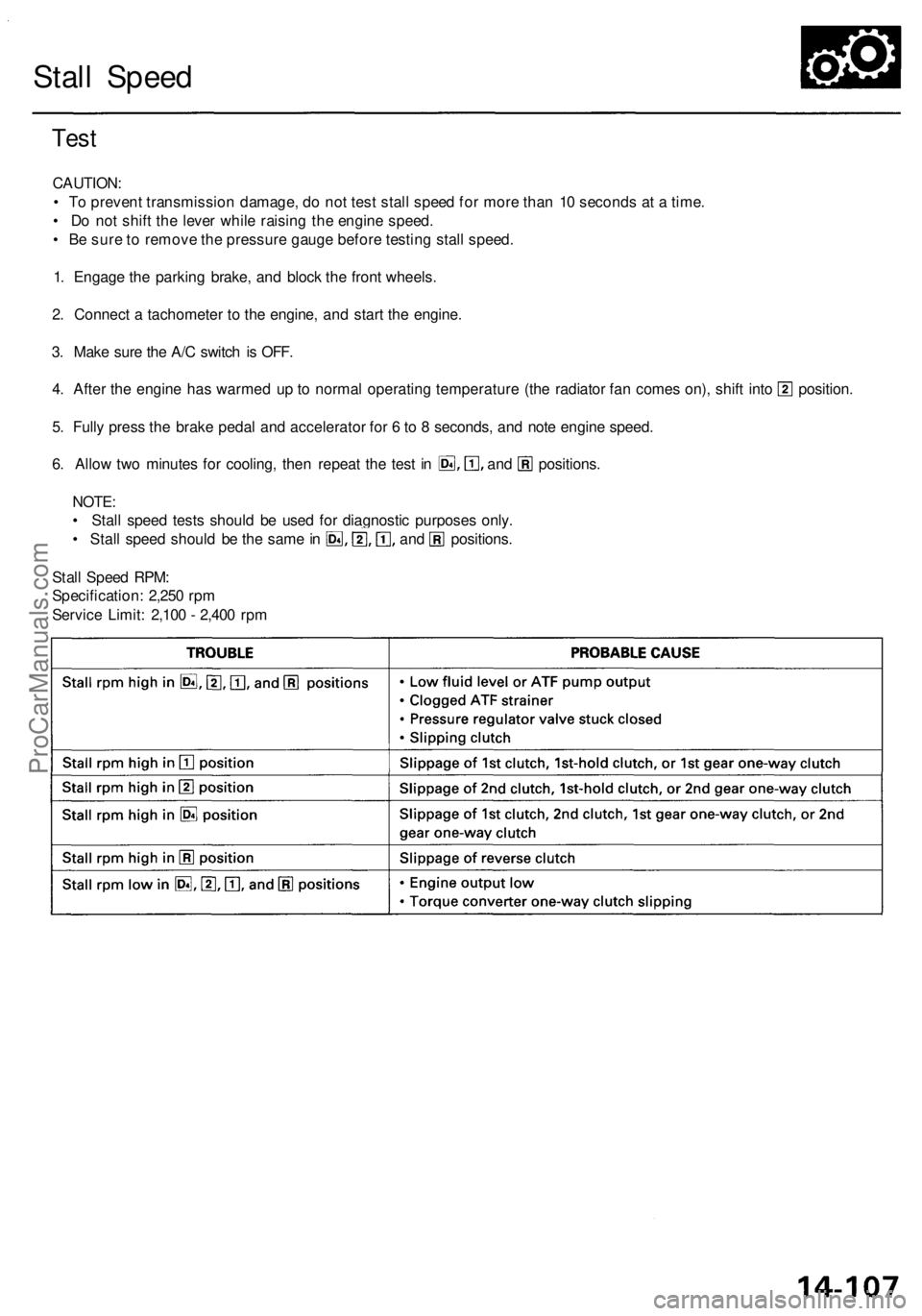
Stall Speed
Test
CAUTION:
• To prevent transmission damage, do not test stall speed for more than 10 seconds at a time.
• Do not shift the lever while raising the engine speed.
• Be sure to remove the pressure gauge before testing stall speed.
1. Engage the parking brake, and block the front wheels.
2. Connect a tachometer to the engine, and start the engine.
3. Make sure the A/C switch is OFF.
4. After the engine has warmed up to normal operating temperature (the radiator fan comes on), shift into position.
5. Fully press the brake pedal and accelerator for 6 to 8 seconds, and note engine speed.
6. Allow two minutes for cooling, then repeat the test in and positions.
NOTE:
• Stall speed tests should be used for diagnostic purposes only.
• Stall speed should be the same in and positions.
Stall Speed RPM:
Specification: 2,250 rpm
Service Limit: 2,100 - 2,400 rpmProCarManuals.com
Page 1027 of 1954
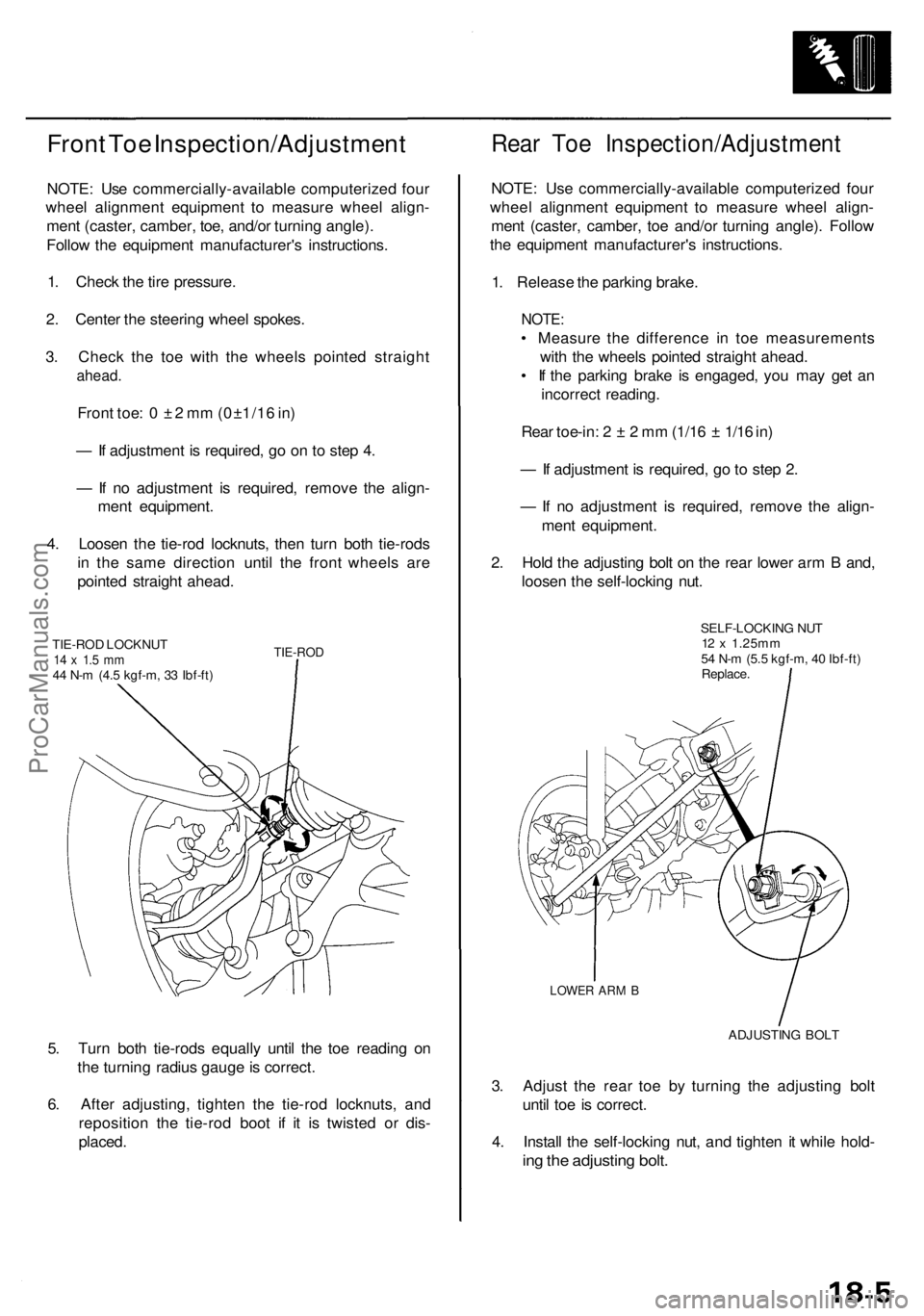
Front Toe Inspection/Adjustment
NOTE: Use commercially-available computerized four
wheel alignment equipment to measure wheel align-
ment (caster, camber, toe, and/or turning angle).
Follow the equipment manufacturer's instructions.
1. Check the tire pressure.
2. Center the steering wheel spokes.
3. Check the toe with the wheels pointed straight
ahead.
Front toe: 0 ± 2 mm (0±1/16 in)
— If adjustment is required, go on to step 4.
— If no adjustment is required, remove the align-
ment equipment.
4. Loosen the tie-rod locknuts, then turn both tie-rods
in the same direction until the front wheels are
pointed straight ahead.
TIE-ROD LOCKNUT
14 x 1.5 mm
44 N-m (4.5 kgf-m, 33 Ibf-ft)
TIE-ROD
5. Turn both tie-rods equally until the toe reading on
the turning radius gauge is correct.
6. After adjusting, tighten the tie-rod locknuts, and
reposition the tie-rod boot if it is twisted or dis-
placed.
Rear Toe Inspection/Adjustment
NOTE: Use commercially-available computerized four
wheel alignment equipment to measure wheel align-
ment (caster, camber, toe and/or turning angle). Follow
the equipment manufacturer's instructions.
1. Release the parking brake.
NOTE:
• Measure the difference in toe measurements
with the wheels pointed straight ahead.
• If the parking brake is engaged, you may get an
incorrect reading.
Rear toe-in: 2 ± 2 mm (1/16 ± 1/16 in)
— If adjustment is required, go to step 2.
— If no adjustment is required, remove the align-
ment equipment.
2. Hold the adjusting bolt on the rear lower arm B and,
loosen the self-locking nut.
SELF-LOCKING NUT
12 x 1.25mm
54 N-m (5.5 kgf-m, 40 Ibf-ft)
Replace.
LOWER ARM B
ADJUSTING BOLT
3. Adjust the rear toe by turning the adjusting bolt
until toe is correct.
4. Install the self-locking nut, and tighten it while hold-
ing the adjusting bolt.ProCarManuals.com
Page 1041 of 1954
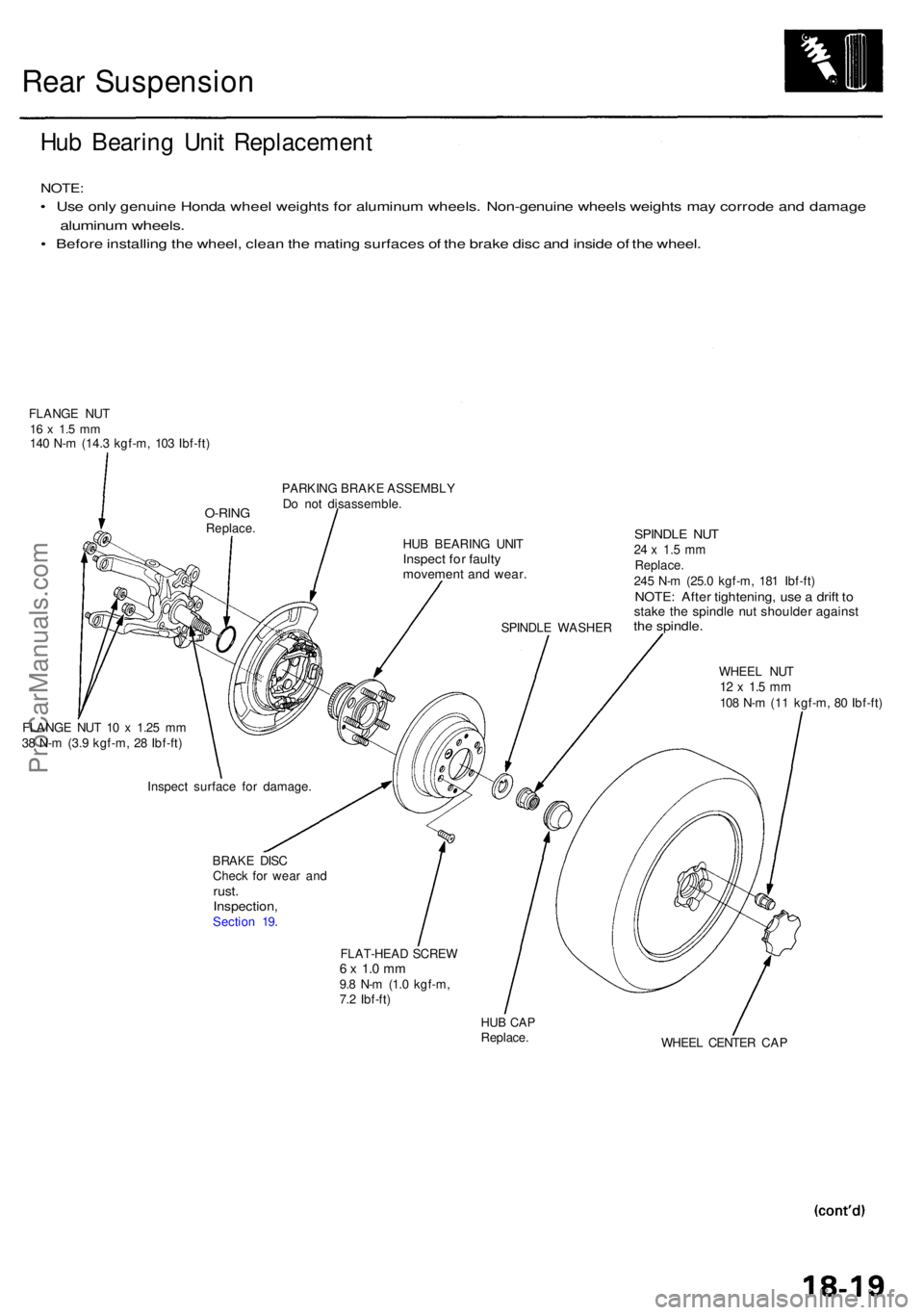
Rear Suspensio n
Hub Bearin g Uni t Replacemen t
NOTE:
• Us e onl y genuin e Hond a whee l weight s fo r aluminu m wheels . Non-genuin e wheel s weight s ma y corrod e an d damag e
aluminum wheels .
• Befor e installin g th e wheel , clea n th e matin g surface s o f th e brak e dis c an d insid e o f th e wheel .
FLANG E NU T16 x 1. 5 m m140 N- m (14. 3 kgf-m , 10 3 Ibf-ft )
PARKING BRAK E ASSEMBL Y
D o no t disassemble .
HU B BEARIN G UNI T
Inspec t fo r fault ymovemen t an d wear .
SPINDL E WASHE R
SPINDLE NU T24 x 1. 5 m mReplace .245 N- m (25. 0 kgf-m , 18 1 Ibf-ft )NOTE : Afte r tightening , us e a drif t t ostak e th e spindl e nu t shoulde r agains tthe spindle .
WHEEL NU T12 x 1. 5 m m108 N- m (1 1 kgf-m , 8 0 Ibf-ft )
FLANG E NU T 1 0 x 1.2 5 m m
3 8 N- m (3. 9 kgf-m , 2 8 Ibf-ft )
BRAKE DIS C
Chec k fo r wea r an d
rust .Inspection ,Section 19 .
FLAT-HEAD SCRE W
6 x 1. 0 m m9.8 N- m (1. 0 kgf-m ,
7. 2 Ibf-ft )
HUB CA PReplace .
WHEEL CENTE R CA P
Inspec
t surfac e fo r damage .
O-RINGReplace .
ProCarManuals.com
Page 1052 of 1954
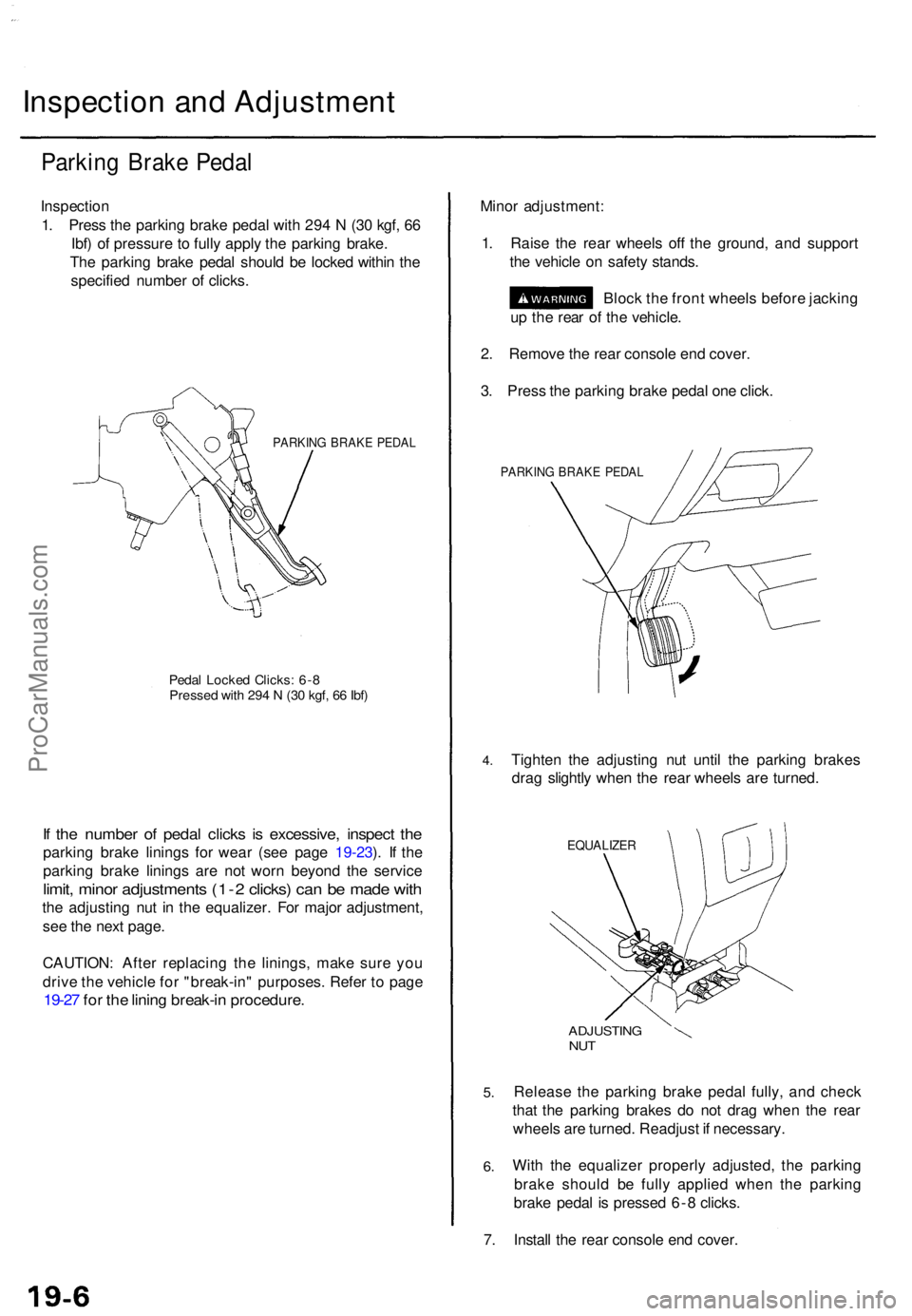
Inspection an d Adjustmen t
Parking Brak e Peda l
Inspectio n
1 . Pres s th e parkin g brak e peda l wit h 29 4 N (3 0 kgf , 6 6
Ibf ) o f pressur e to full y appl y th e parkin g brake .
Th e parkin g brak e peda l shoul d b e locke d withi n th e
specifie d numbe r o f clicks .
PARKIN G BRAK E PEDA L
Pedal Locke d Clicks : 6- 8Presse d wit h 29 4 N (3 0 kgf , 6 6 Ibf )
If th e numbe r o f peda l click s i s excessive , inspec t th e
parkin g brak e lining s fo r wea r (se e pag e 19-23 ). I f th e
parkin g brak e lining s ar e no t wor n beyon d th e servic e
limit, mino r adjustment s (1- 2 clicks ) ca n b e mad e wit h
the adjustin g nu t i n th e equalizer . Fo r majo r adjustment ,
se e th e nex t page .
CAUTION : Afte r replacin g th e linings , mak e sur e yo u
driv e th e vehicl e fo r "break-in " purposes . Refe r t o pag e
19-27 fo r th e linin g break-i n procedure .
Minor adjustment :
1 . Rais e th e rea r wheel s of f th e ground , an d suppor t
th e vehicl e o n safet y stands .
Bloc k th e fron t wheel s befor e jackin g
u p th e rea r o f th e vehicle .
2 . Remov e th e rea r consol e en d cover .
3 . Pres s th e parkin g brak e peda l on e click .
PARKIN G BRAK E PEDA L
4.Tighte n th e adjustin g nu t unti l th e parkin g brake s
dra g slightl y whe n th e rea r wheel s ar e turned .
EQUALIZE R
5.
6.
ADJUSTIN GNUT
Releas e th e parkin g brak e peda l fully , an d chec k
tha t th e parkin g brake s d o no t dra g whe n th e rea r
wheel s ar e turned . Readjus t i f necessary .
Wit h th e equalize r properl y adjusted , th e parkin g
brak e shoul d b e full y applie d whe n th e parkin g
brak e peda l i s presse d 6- 8 clicks .
7 . Instal l th e rea r consol e en d cover .
ProCarManuals.com
Page 1055 of 1954
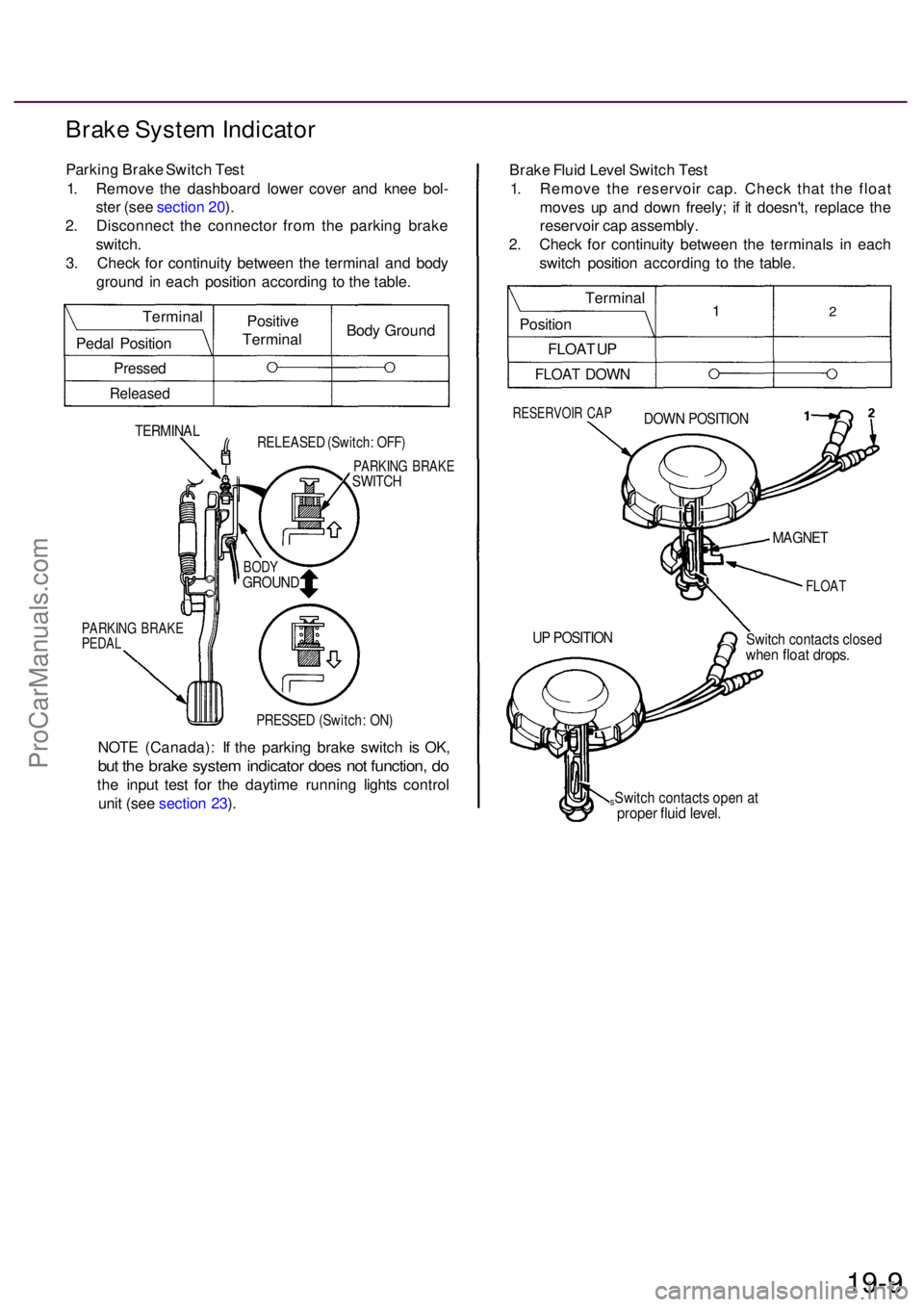
Brake Syste m Indicato r
Parking Brak e Switc h Tes t
1 . Remov e th e dashboar d lowe r cove r an d kne e bol -
ste r (se e sectio n 20 ).
2 . Disconnec t th e connecto r fro m th e parkin g brak e
switch .
3 . Chec k fo r continuit y betwee n th e termina l an d bod y
groun d i n eac h positio n accordin g t o th e table .
TERMINA LRELEASE D (Switch : OFF )
PARKIN G BRAK ESWITCH
PARKIN G BRAK EPEDAL
PRESSE D (Switch : ON )
NOT E (Canada) : I f th e parkin g brak e switc h i s OK ,
but th e brak e syste m indicato r doe s no t function , d o
th e inpu t tes t fo r th e daytim e runnin g light s contro l
uni t (se e sectio n 23 ). Brak
e Flui d Leve l Switc h Tes t
1 . Remov e th e reservoi r cap . Chec k tha t th e floa t
move s u p an d dow n freely ; i f i t doesn't , replac e th e
reservoi r ca p assembly .
2 . Chec k fo r continuit y betwee n th e terminal s i n eac h
switc h positio n accordin g t o th e table .
RESERVOI R CA PDOW N POSITIO N
FLOAT
Switch contact s close dwhen floa t drops .
sSwitch contact s ope n a tprope r flui d level .
19-9
UP POSITIO N
MAGNET
BODYGROUN D
Positive
Termina lBod
y Groun d
Termina
l
Peda l Positio n
Pressed
Release d
Termina l
Positio n
FLOA T U P
FLOA T DOW N
12
ProCarManuals.com
Page 1072 of 1954
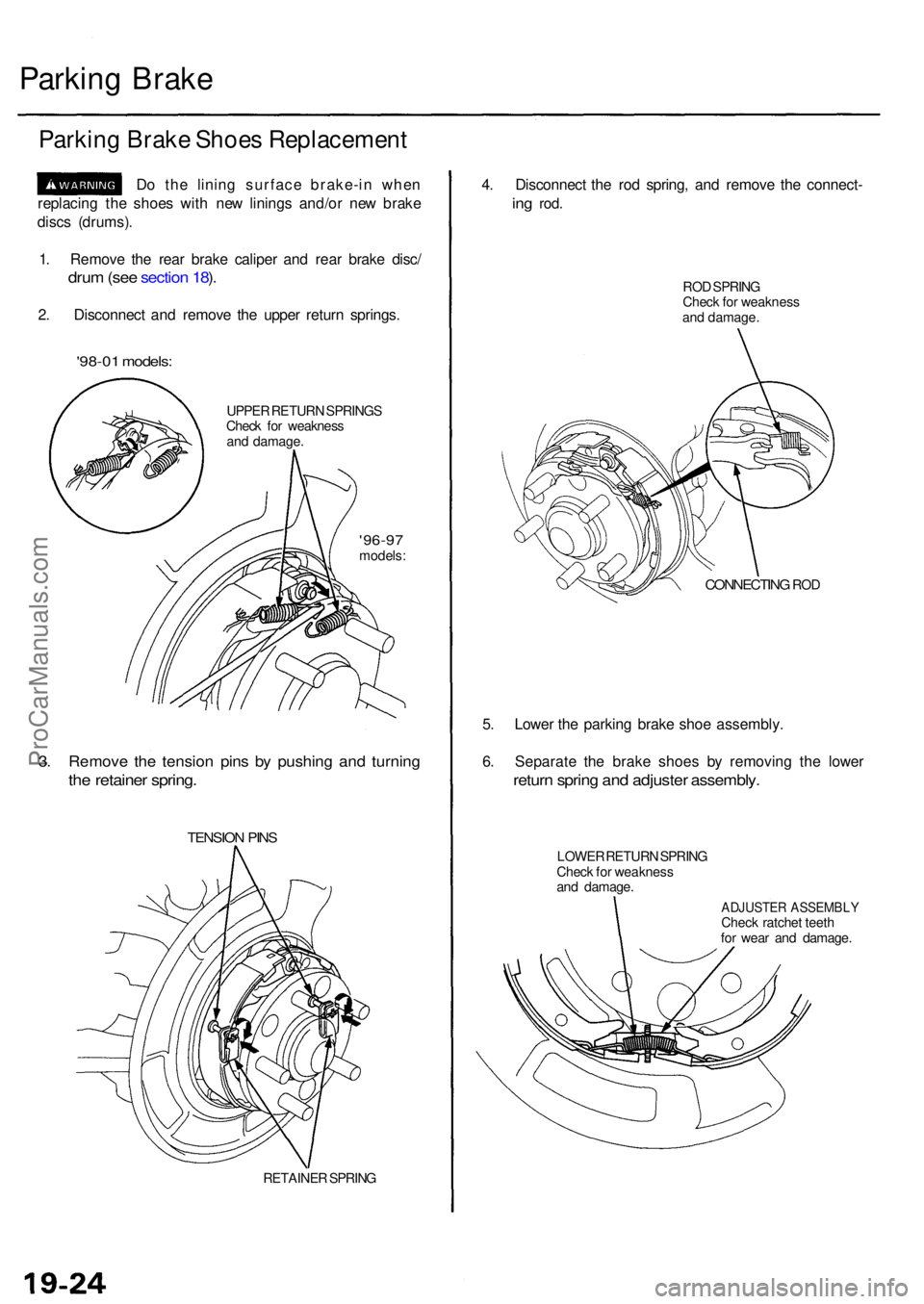
Parking Brak e
Parkin g Brak e Shoe s Replacemen t
Do th e linin g surfac e brake-i n whe n
replacin g th e shoe s wit h ne w lining s and/o r ne w brak e
disc s (drums) .
1 . Remov e th e rea r brak e calipe r an d rea r brak e disc /
drum (se e sectio n 18 ).
2 . Disconnec t an d remov e th e uppe r retur n springs .
'98-01 models :
UPPER RETUR N SPRING S
Chec k fo r weaknes s
an d damage .
'96-97models :
3. Remov e th e tensio n pin s b y pushin g an d turnin g
the retaine r spring .
TENSIO N PIN S
RETAINE R SPRIN G
4. Disconnec t th e ro d spring , an d remov e th e connect -
ing rod .
ROD SPRIN G
Chec k fo r weaknes s
an d damage .
CONNECTIN G ROD
5. Lowe r th e parkin g brak e sho e assembly .
6 . Separat e th e brak e shoe s b y removin g th e lowe r
return sprin g an d adjuste r assembly .
LOWER RETUR N SPRIN G
Chec k fo r weaknes s
an d damage .
ADJUSTE R ASSEMBL YCheck ratche t teet h
fo r wea r an d damage .
ProCarManuals.com
Page 1073 of 1954
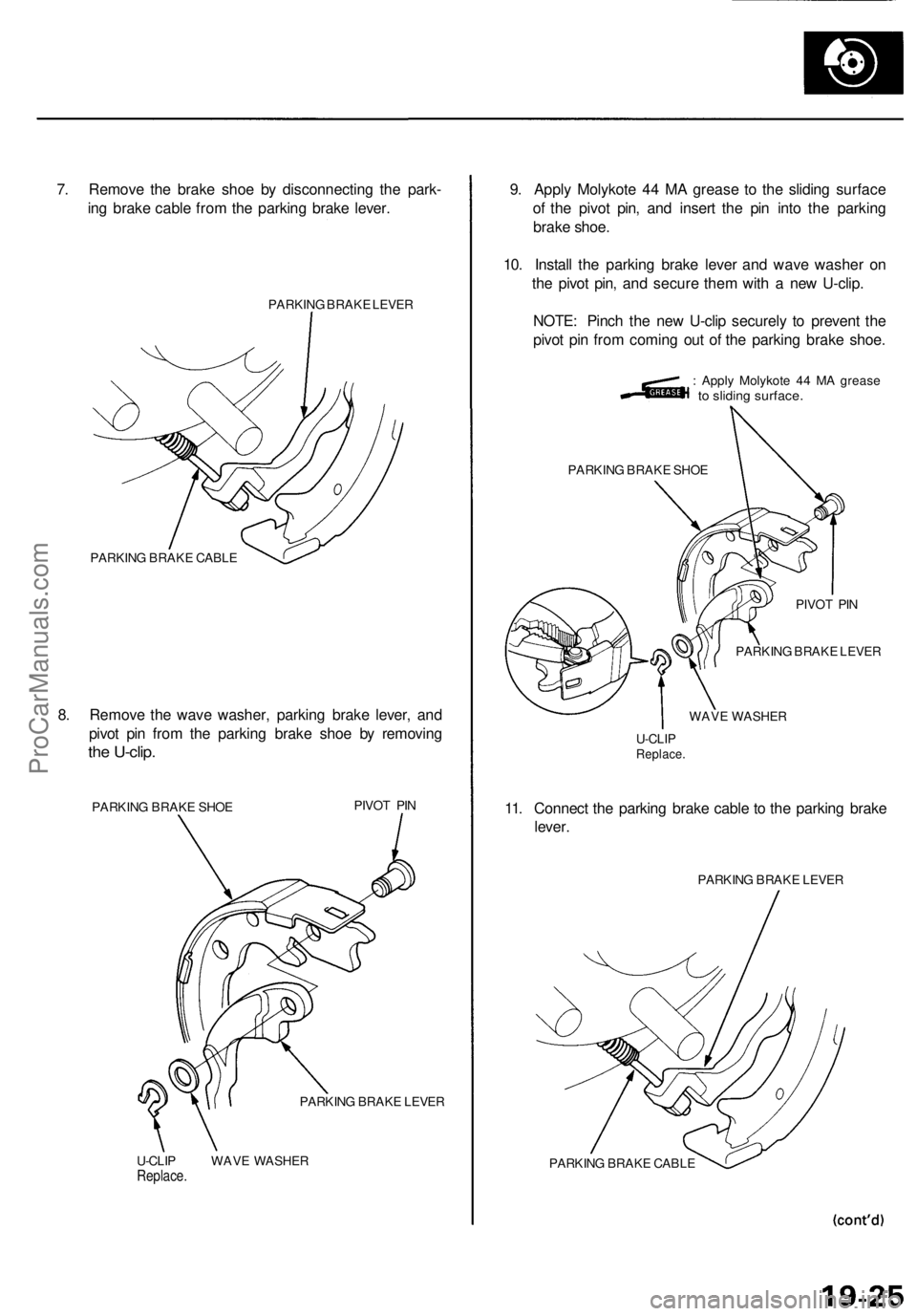
7. Remove the brake shoe by disconnecting the park-
ing brake cable from the parking brake lever.
PARKING BRAKE LEVER
PARKING BRAKE CABLE
8. Remove the wave washer, parking brake lever, and
pivot pin from the parking brake shoe by removing
the U-clip.
PARKING BRAKE SHOE
PIVOT PIN
PARKING BRAKE LEVER
U-CLIP WAVE WASHER
Replace.
9. Apply Molykote 44 MA grease to the sliding surface
of the pivot pin, and insert the pin into the parking
brake shoe.
10. Install the parking brake lever and wave washer on
the pivot pin, and secure them with a new U-clip.
NOTE: Pinch the new U-clip securely to prevent the
pivot pin from coming out of the parking brake shoe.
: Apply Molykote 44 MA grease
to sliding surface.
PARKING BRAKE SHOE
PIVOT PIN
PARKING BRAKE LEVER
WAVE WASHER
U-CLIP
Replace.
11. Connect the parking brake cable to the parking brake
lever.
PARKING BRAKE LEVER
PARKING BRAKE CABLEProCarManuals.com
Page 1074 of 1954
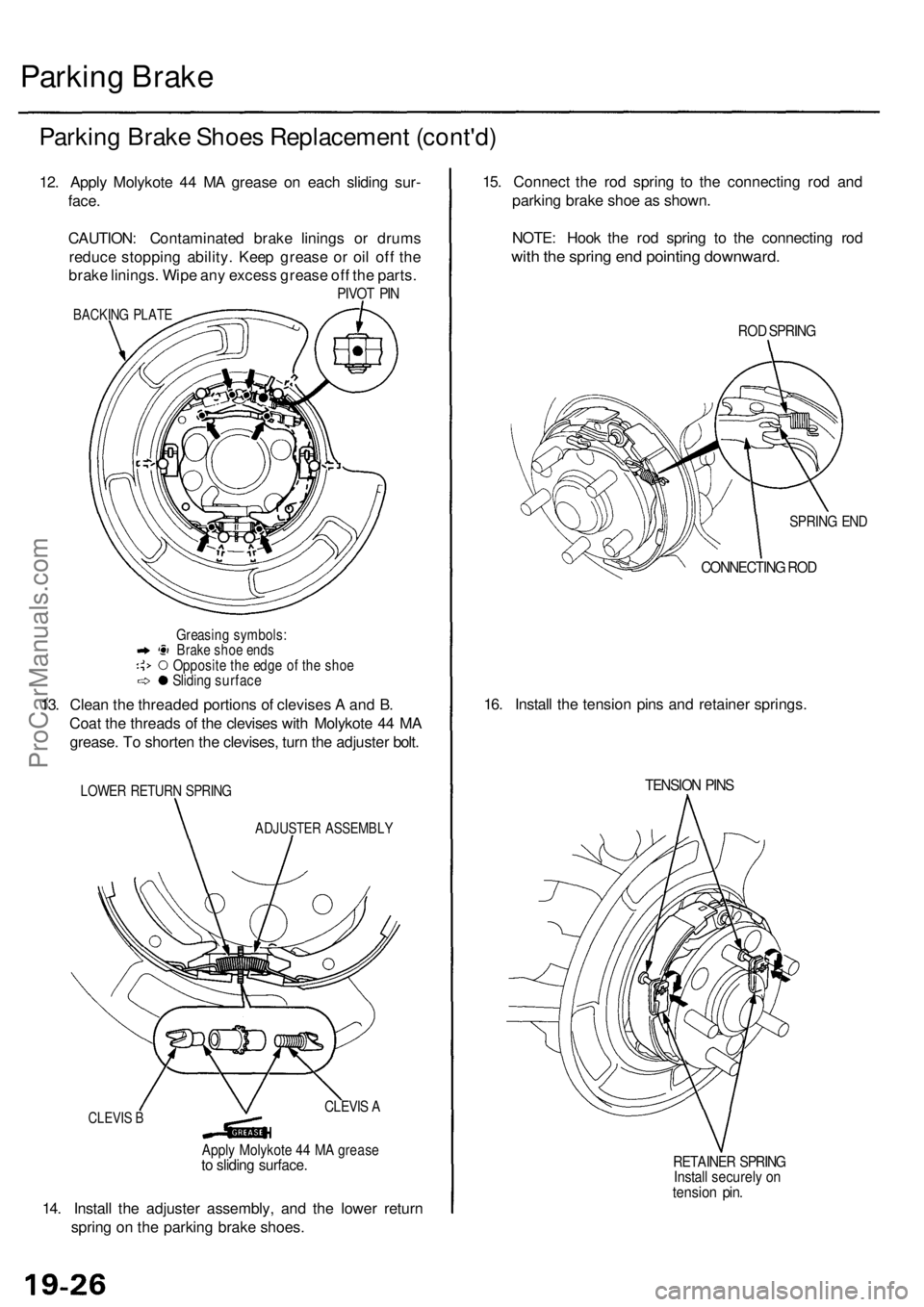
Parking Brake
Parking Brake Shoes Replacement (cont'd)
12. Apply Molykote 44 MA grease on each sliding sur-
face.
CAUTION: Contaminated brake linings or drums
reduce stopping ability. Keep grease or oil off the
brake linings. Wipe any excess grease off the parts.
PIVOT PIN
BACKING PLATE
Greasing symbols:
Brake shoe ends
Opposite the edge of the shoe
Sliding surface
13. Clean the threaded portions of clevises A and B.
Coat the threads of the clevises with Molykote 44 MA
grease. To shorten the clevises, turn the adjuster bolt.
LOWER RETURN SPRING
ADJUSTER ASSEMBLY
14. Install the adjuster assembly, and the lower return
spring on the parking brake shoes.
15. Connect the rod spring to the connecting rod and
parking brake shoe as shown.
NOTE: Hook the rod spring to the connecting rod
with the spring end pointing downward.
ROD SPRING
SPRING END
CONNECTING ROD
16. Install the tension pins and retainer springs.
TENSION PINS
RETAINER SPRING
Install securely on
tension pin.
CLEVIS B
CLEVIS A
Apply Molykote 44 MA grease
to sliding surface.ProCarManuals.com
Page 1084 of 1954

Troubleshooting Precautions
ABS Indicator Light:
The ABS indicator light comes on for 3 seconds and then goes off when the control unit detects no problem during the ini-
tial diagnosis right after the engine starts. However, the ABS indicator light can stay on for up to 40 seconds when the
control unit starts to check for pump overrun, etc. during the initial diagnosis. The ABS indicator light comes on, and the
ABS control unit memorizes the diagnostic trouble code (DTC) under certain conditions.
The parking brake is applied for more than 30 seconds while the vehicle is being driven. (DTC 2-1)
The transmission downshifted excessively. (DTC 4-1, 4-2)
The vehicle loses traction, and the front wheels spin for more than 1 minute when starting from a stuck condition on a
muddy, snowy, or sandy road. (DTC 4-8)
Tire adhesion is lost due to excessive cornering speed. (DTC 5, 5-4, 5-8)
The vehicle is driven on an extremely rough road. (DTC 8-1)
The vehicle is interfered by strong radio waves (noise), for example, illegal radio, etc. (DTC 8-2)
NOTE: If there is any trouble in the system, the ABS indicator light comes on during driving.
Diagnostic Trouble Code (DTC):
When the control unit detects a problem and the ABS indicator light comes on, the control unit memorizes the DTC.
The control unit has three memory registers. When a problem occurs, the control unit stores the DTC in the first memory
register. If another problem occurs, or the same problem occurs again, the control unit moves the first DTC to the next
memory register, and stores the second DTC in the first register. If there's a third problem occurrence, the two existing
DTCs are moved up one register, and the third DTC is stored in the first register. If problems continue to occur, the oldest
problem is moved out of the last register and lost, and the most recent problem is stored in the first register. When the
same problem occurs three times, the same DTC is stored in all memory registers. (Refer to the Symptom-to-System
Chart for diagnostic period.)
The most recent DTC is indicated first, and the oldest DTC is indicated last.
The DTCs are erased from the control unit when the ABS control unit +B2 power supply or connector is disconnected.
The control unit's memory can be erased by disconnecting the ABS B2 fuse for more than 3 seconds.
Self-diagnosis:
There are three self-diagnoses described below.
Initial diagnosis: Performed right after the engine starts until the ABS indicator light goes off.
Regular diagnosis: Continuously performed (under some conditions) after the ABS indicator light goes off until the
engine stops.
Individual part/system diagnosis: Diagnosis about a specific part/system under its operating conditions.
The CPU (central processing unit) controls the following when it detects a problem during self-diagnosis:
Turns the ABS indicator light ON.
Turns the front and rear fail-safe relays off.
Stops the ABS control.
Stops the ABS pump. (The pump may work under some conditions.)
After the DTC is stored in the control unit, the CPU stops self-diagnosis.ProCarManuals.com
Page 1114 of 1954

Troubleshooting
DTC 5 , 5-4 , 5-8 : Rea r Whee l Loc k
The AB S contro l uni t monitor s th e rea r whee l senso r signal s durin g th e regula r diagnosi s (durin g driving) . Thi s diagnosi s
is no t performe d whe n th e parkin g brak e signa l i s ON . Th e AB S contro l uni t turn s th e AB S indicato r ligh t o n if i t detect s n o
signal(s ) fro m th e rea r whee l sensor(s ) du e to , fo r example , rea r whee l lock .
Possibl e causes :
Wheel spi n durin g cornerin g
Open circuit , interna l shor t o r shor t t o th e bod y groun d in th e whee l senso r syste m
Rear brak e dra g
Modulato r doe s no t decreas e pressur e properl y
Faulty AB S contro l uni t
— Whe n vehicl e i s driven , ABSindicato r ligh t i s ON .— Wit h th e SC S servic e connec -tor connecte d (se e pag e 19-40 ),DTC s 5 , 5- 4 and/o r 5- 8 ar e indi -
cated .
Chec k th e PAR K circuit :
1. Tur n th e ignitio n switc h O N (II) .2. Pres s th e parking brake pedal .
Doe s th e brak e syste m ligh t
com e on ? Parkin
g brak e switc h stuc k OFF .
Repai r ope n circui t betwee n th e
under-das h fuse/rela y bo x an d
parkin g brak e switch .
NOTE:The self-diagnosi s o f th e whee l senso r i s per -forme d i n thi s step .
Test-driv e wit h th e parkin g brak e released .
Does th e AB S indicato r ligh tcom e on ?
Chec k fo r rea r brak e drag :
1 . Rais e th e rea r o f th e vehicle ,
and suppor t i t wit h safet ystands (se e sectio n 1 ).2 . Spi n th e lef t and/o r righ t rea rwhee l an d chec k fo r brak e
drag . I
s cod e 4- 4 o r 4- 8 indicated ?
Perform th e troubleshootin g fo rthe rea r whee l sensor .
Perfor m th e appropriat e trouble -
shootin g fo r th e code .
Doe s th e brak e drag ?
Repair th e rea r brak e drag .
Check th e AB S functio n (se epage 19-95 ).
Th e probabl e caus e wa s tha t
tractio n wa s los t du e t o exces -
siv e cornerin g speed , etc .
Chec
k th e self-diagnosis :
Test-driv e th e vehicl e a t speed s
of 6 mp h (1 0 km/h ) o r more .
Confir m th e DT C (se e pag e 19-40 ).
ProCarManuals.com